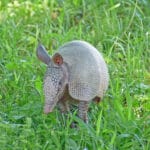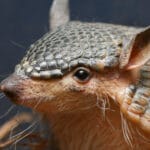How Good is an Armadillo’s Eyesight? Debunking the Blind Myth & Unveiling Their Sensory World
Armadillos: those armored, burrowing creatures often seen snuffling around yards and roadsides. But are these fascinating animals truly blind, as many believe? While the truth is a bit more nuanced, it’s safe to say that armadillos aren’t winning any staring contests. Their eyesight is surprisingly poor, especially in bright daylight. However, they’ve evolved an impressive array of other senses to navigate their world. Let’s delve into the fascinating reality of armadillo vision and discover how these creatures thrive despite their blurred view of the world.
A World Out of Focus: Understanding Armadillo Vision
The myth that armadillos are completely blind is just that—a myth. These animals can see, but their vision is far from perfect. Imagine a world that’s mostly out of focus, lacking vibrant colors, and where shapes only become clear when they move. That’s pretty much the visual experience of an armadillo, especially during the day.
Several factors contribute to their limited eyesight:
- Rod-Dominant Vision: Armadillo eyes are packed with light-sensitive cells called “rods,” which excel in low-light conditions. This makes their night vision surprisingly decent. However, rods aren’t great at picking up color or sharp details, hence the blurry, colorless world they experience.
- Limited Color Vision: Unlike many mammals, armadillos have few cone cells, the receptors responsible for color vision. Research suggests they may only perceive a limited range of colors, possibly seeing the world in shades of gray.
- Overwhelmed by Daylight: While their rod-heavy eyes work well in low light, bright daylight overloads these sensitive cells. This essentially renders armadillos functionally blind during the day, making it difficult for them to navigate their surroundings or spot predators.
Sensory Superstars: Compensating for Poor Eyesight
Armadillos may not have the sharpest eyesight, but nature, as always, has provided them with remarkable adaptations to thrive. Their other senses—smell and hearing—are highly developed, more than making up for their visual shortcomings.
- The Power of Scent: Their sense of smell is their true superpower! Armadillos rely heavily on their incredibly keen noses to locate food, especially insects and grubs hidden underground. They can sniff out an earthworm buried a whopping 8 inches beneath the surface! This acute sense of smell is also crucial for detecting predators and even communicating with each other through scent markings.
- Hearing on High Alert: While not their primary sense, armadillos possess excellent hearing that plays a vital role in their survival. They use their sharp ears to detect the movements of predators, locate rustling leaves that might signal a tasty insect, and even navigate their surroundings. Their ears are particularly sensitive to low-frequency sounds, like the vibrations of insects moving underground.
Beyond the Blur: Why Poor Eyesight Works for Armadillos
You might wonder why evolution would favor a creature with such limited vision. The answer, like most things in nature, lies in adaptation and survival strategies.
- Nocturnal Lifestyle: Armadillos are primarily nocturnal creatures. This means they’re most active at night when their rod-dominated vision gives them an advantage in low-light conditions. Their reliance on smell and hearing further enhances their ability to navigate and find food in the dark.
- Underground Dwellers: Armadillos are expert diggers, creating elaborate burrows for shelter and raising their young. Spending a significant portion of their lives underground, in darkness, reduces their need for acute vision. Their sensitive noses and ability to detect vibrations become far more valuable in these environments.
A Window into Human Vision? The Scientific Significance of Armadillo Eyes
Interestingly, the armadillo’s seemingly “weak” eyesight offers a unique opportunity for scientific exploration. Researchers believe that studying their rod-dominant vision and its limitations could unlock clues to understanding and potentially treating human eye diseases.
For example, retinitis pigmentosa, a group of genetic disorders that cause vision loss in humans, primarily affects rod cells. By studying how armadillos function with their rod-heavy vision, scientists hope to gain insights into the progression of this disease and potentially develop new therapies.
The Takeaway: Armadillos Demonstrate that Nature Finds a Way
The armadillo’s story reminds us that there’s more to the animal kingdom than meets the (sometimes blurry) eye. Their incredible adaptations, particularly their highly developed senses of smell and hearing, demonstrate that nature is a master of problem-solving. While their eyesight may be weak, armadillos have carved out a successful niche for themselves by relying on their other remarkable sensory abilities. And who knows, their unique vision may even hold the key to improving human eye health in the future.
For more fascinating insights into the animal kingdom, check out our article on the bearded dragon average lifespan. While you’re at it, discover the intriguing world of armadillos in Georgia, where these fascinating creatures continue to capture our curiosity.
- Georgia Platform: A Southern Strategy, 1850s - March 31, 2025
- How many weeks is 40 days: Quick Conversion Guide for Accurate Results - March 31, 2025
- How many feet is 300 meters? 984 Feet: Understand Length Conversions Easily - March 31, 2025
















